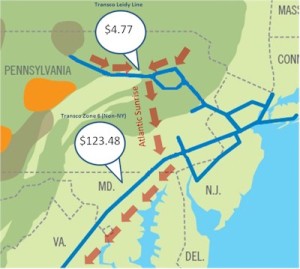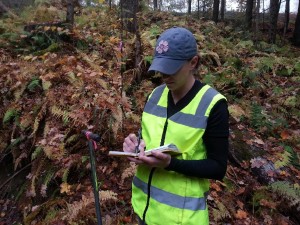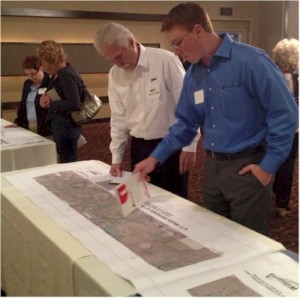Williams operates a natural gas transmission pipeline known as the Transco pipeline, which transports natural gas from production areas to customers such as utility companies and power plants located throughout the northeastern and southeastern United States.
The natural gas supply landscape has shifted in recent years as a result of new gas discoveries, particularly located in the Northeast. As a result, the popularity of natural gas has never been higher. Today, because of its environmental advantages, natural gas fuels one-third of electric power generation and heats half of all U.S. homes — and those numbers continue to climb. Although the price of natural gas has fallen to historic lows in some regions of the U.S., a lack of sufficient pipeline infrastructure has prevented most consumers from realizing the full economic advantages of this abundant, domestic resource.
In response to this supply shift, Williams is in the preliminary stages of developing a pipeline proposal known as the Atlantic Sunrise Project. This proposal is being designed to help debottleneck pipeline capacity constraints that lead to higher energy bills, while allowing Williams to continue to ensure reliable natural gas service. It would include expanding the existing Transco transmission pipeline by adding new pipeline infrastructure in Pennsylvania, as well as modifying some existing Transco facilities in other states, to allow gas to flow from north to south.
Project Scope
The Atlantic Sunrise Project is designed to add 1,700,000 dekatherms per day of pipeline capacity to the Transco system (enough natural gas to meet the daily needs of more than 7 million American homes) connecting producing regions in northeastern Pennsylvania to markets in the Mid-Atlantic and southeastern states, as far south as Georgia and Alabama.
The project will consist of compression and looping of the Transco Leidy Line in Pennsylvania along with a greenfield pipeline segment, referred to as the Central Penn Line, connecting the northeastern Marcellus producing region to the Transco mainline near Station 195 in southeastern Pennsylvania. Additional existing Transco facilities are being added or modified to allow gas to flow bi-directionally.
The preliminary project design includes a total of approximately 178 miles of new greenfield pipe (Central Penn North & Central Penn South), two pipeline loops totaling about 12 miles (Chapman Loop, Unity Loop), two and half miles of existing pipeline replacement, two new compressor facilities in Pennsylvania, and other facility additions or modifications in five states (Pennsylvania, Maryland, Virginia, North Carolina, South Carolina). [More info]
Ground Surveys
Ground surveys are a preliminary first step in gathering critical information that can be used in developing the pipeline proposal. Initial ground surveys (environmental, cultural and civil surveys) for the Atlantic Sunrise Project are scheduled to begin in the spring of 2014. After receiving permission from the landowner, each property will be visited by various specialists in engineering, cultural and environmental sciences. These may or may not be concurrent visits but should not last longer than one or two days each. Survey crews typically move through a given area in about a week. All information collected will be used to help determine the best location of the proposed pipeline facilities. [More info]
Selecting Facility Locations
In developing the pipeline project, engineers attempt to balance environmental and landowner considerations with the engineering requirements for safely constructing a transmission pipeline. These factors include geography, environmental concerns, co-location with other linear development and constructability.
Sophisticated computer modeling is used to identify what new pipeline facilities will be required to create the necessary pipeline capacity requested by the project customers. Increasing natural gas deliveries can be accomplished through one or a combination of the following:
- Increasing horsepower at pipeline compressor stations or building new compressor stations;
- Replacing existing pipeline with larger pipeline;
- Building new pipeline, either next to existing pipes or in an area where pipelines don’t currently exist (sometimes referred to as “greenfield” pipelines).
The pipeline company must evaluate a number of environmental factors, including potential impacts on residents, threatened and endangered species, wetlands, water bodies, groundwater, fish, vegetation, wildlife, cultural resources, geology, soils, land use, air and noise quality.
Pipeline companies are strongly encouraged by regulators to consider routes along existing corridors, such as pipeline rights of way, roadways, utility corridors, railroad corridors and other easements. After analyzing maps, aerial photos, environmental reports and other available data, pipeline engineers establish a preliminary route or location for the new facilities, as well as location alternatives.
Permitting Process
Before any new pipeline facilities can be constructed, Williams must first obtain a federal Certificate of Public Convenience and Necessity from the Federal Energy Regulatory Commission (FERC), in addition to various state permits. In the spring of 2014 Williams requested that the FERC initiate a pre-filing environmental review of the proposed Atlantic Sunrise project. The project was assigned pre-filing docket number PF14-8.
The FERC pre-filing process is intended to solicit early input from citizens, governmental entities and other interested parties to identify and address issues with potential facility locations. The company intends to host a series of public open houses in the late spring of 2014 in the affected areas to formally introduce the proposal to the public and solicit feedback. Public input is important to the project and can shape the final project footprint. [More info]
Preliminary Schedule
- Spring 2014 – Field surveys begin
- Spring 2014 – FERC pre-filing process begins
- Late spring 2014 – Open houses and informational meetings
- Early 2015 – Submit 7(c) application to FERC
- Summer 2016 — Anticipated construction start
- Second half of 2017 – Target in-service
Project Benefits
Preliminary estimates made by researchers at The Pennsylvania State University forecast the Atlantic Sunrise project to directly employ approximately 2,300 employees in the 10 Pennsylvania counties during the project’s one-year construction phase, resulting in an estimated $1.6 billion increase economic activity in the project area. The 2,300 employees would stimulate the local and regional economies in the project area and support an additional 6,000 indirect and induced jobs. The Project is also expected to generate an additional $244 million in labor income in the project area during construction.
Additional positive economic impacts would continue during the operations phase. An estimated 15 full-time permanent positions will be needed to operate and maintain the pipeline, compressor stations, and related facilities. These 15 direct jobs are expected to support an additional 18 indirect and induced jobs. Maintenance and operations expenditures related to the Project are expected to generate approximately $1.9 million in labor income in the project area each year.
Our Commitment
Williams is committed to working with landowners, as well as local, state and federal agencies, to design and construct the project in a manner that minimizes environmental and landowner impacts. The company is committed to extensive public outreach in advance of submitting our application to the FERC. Our goals are to:
- Generate a broad awareness of the project, its purposes and value to the region’s economy and to meeting the future energy needs of the state and region.
- Ensure that community residents and a broad range of stakeholders have ample opportunity to understand the process and their rights, ask questions, voice concerns and present ideas about the project.
- Create an atmosphere of openness, disclosure and public dialogue in which we can respond to questions, concerns and suggestions presented by the community and other stakeholders.




